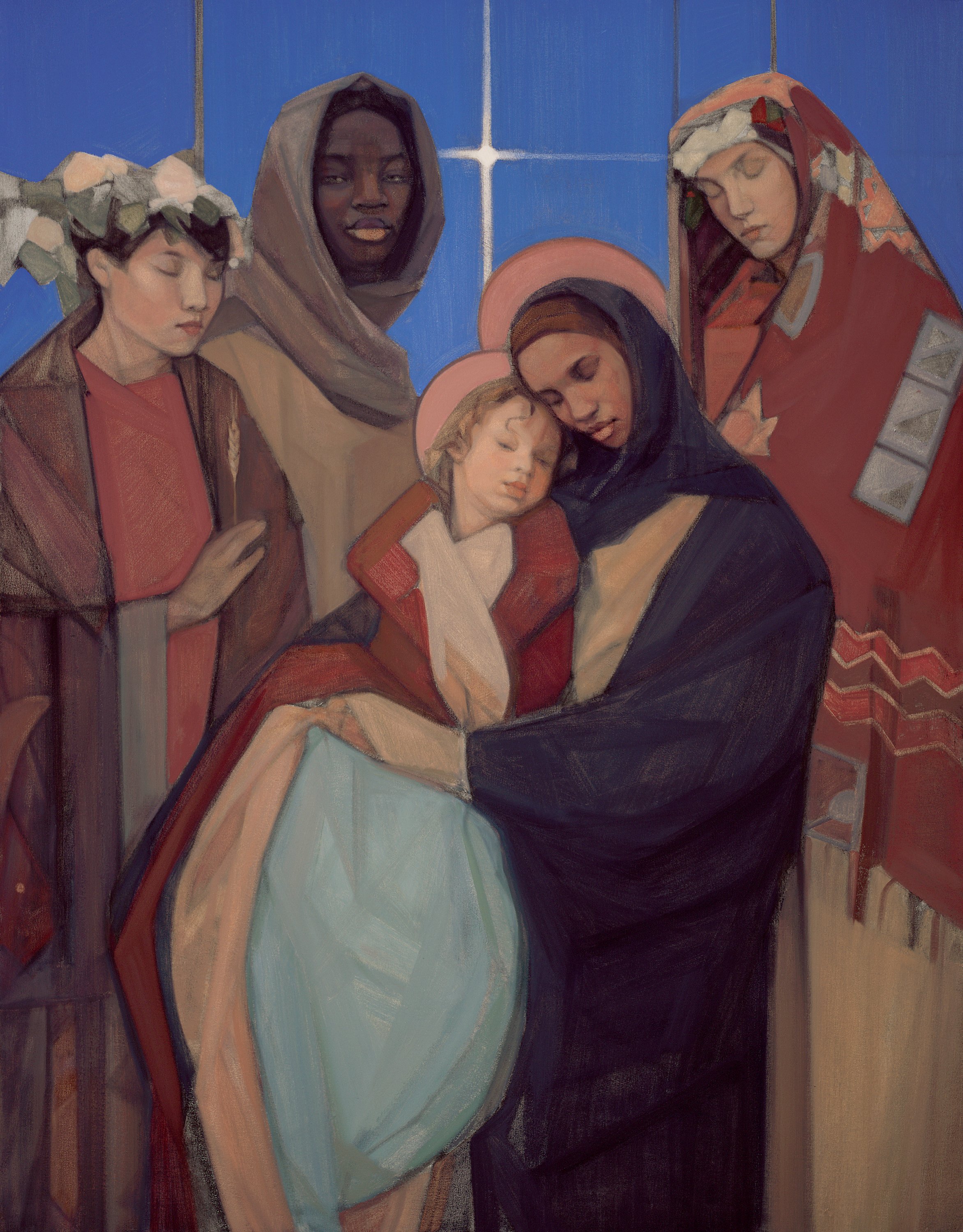
"Epiphany," ©2003 Janet McKenzie, www.janetmckenzie.com, Collection of Catholic Theological Union, Chicago, IL
Throughout the Christmas season, friends occasionally send me cards, cups and other assorted tchotchkes praising the "three Wise Women." You have probably seen them: "Three Wise Women would have asked directions, arrived on time, helped deliver the baby, swept the stable, made a casserole and brought practical gifts."
I love this humorous feminist take on a beloved Christmas story.
But, recently, a renowned authority on the Gospel of Matthew, Dominican Fr. Benedict Thomas Viviano, believes it entirely possible that women could have been among the Magi portrayed in the Matthean birth narrative. Viviano is professor emeritus at the University of Fribourg, Switzerland. He also wrote the commentary on Matthew in The New Jerome Biblical Commentary.
Matthew is the only Gospel that says anything at all about Magi. You may be surprised to learn that this Gospel does not ascribe number, gender or royal status to the Wise Ones from the East. The traditional number three was deduced from the three gifts of gold, frankincense and myrrh, and the idea that the Magi were kings didn't appear until the fifth century. Matthew's use of the Greek masculine plural magoi for magi can be used inclusively, just as the English word "men" often includes women.
But there is more to Viviano's wonderfully provocative claim than grammar. Matthew's Gospel was meant for a Jewish audience. Viviano specializes in examining the book of Matthew in light of its literary connections to the Hebrew Bible (Old Testament). It is upon this analysis that he bases his arguments about female magoi.
According to Viviano, "The main reason to think of the presence of one or more women among the magi is the background story of the queen of Sheba, with her quest for Israelite royal wisdom, her reverent awe, and her three gifts fit for a king."
The first book of Kings, Chapter 10:1-29, narrates the visit of the queen to King Solomon with gifts of gold and spices such as myrrh and frankincense.
Viviano believes viewing the Solomon-Sheba background as a close biblical parallel to the Magi story opens up some "previously neglected possibilities" such as the "wisdom and feminine aspects of the narrative."
He points to the Israelite tradition of personifying wisdom as female (Proverbs 8:22-30, 9:1-6 and Sirach 24) and notes that for Matthew, Jesus embodies wisdom (Matthew 11:19, 25-30).
Even more compelling to me is that in the Middle East it would have been inconceivable for men to be in the presence of a woman without the presence of other women. Joseph is conspicuously absent when the Magi visit. This is surprising, since Matthew's infancy account normally narrates events from the point of view of Joseph. (In Luke's account, Mary is more prominent).
The phrase "the child and his mother" is used five times in the Magi-flight-into-Egypt narrative (Matthew 2:11, 13, 14, 19, 21). For Viviano, "The presence of Jesus' mother Mary is an explicit statement of the presence of a woman at the time of the magi's visit. It is a question of attending to the feminine resonances in the text."
Scholars tell us that the magoi were a caste associated with the interpretation of dreams, astrology, Zoroastrianism and magic. In support of Viviano's thesis, Zoroastrianism allowed women to serve as priests and in ancient Persia there were female astronomers and rulers.
According to the late Sulpician Fr. Raymond E. Brown, an acclaimed biblical scholar, scholars believe the magoi probably hailed from one of three places: Persia (present day Iran) because term magoi was originally associated with Persians; Babylon (Iraq) because Babylonians were interested in astronomy and astrology and there was a large Jewish colony there; or Arabia because of the gifts of gold and frankincense associated with Sheba.
But what can be said about the historicity of Matthew's Magi story?
I think Viviano's discussion in The New Jerome Biblical Commentary has it right. While the Matthean infancy narrative has several likely historical elements in common with Luke's account (Jesus was of the tribe of Judah, born in Bethlehem and raised in Nazareth), "there are also some legendary elements in Matthew 1 and 2" that Brown identifies as a "genre of infancy narratives of famous men."
In the ancient world, it was common to retrospectively ascribe unusual signs in the heavens (a rising star) and events on earth (portents and predictions by wisdom figures) to the birth of a new and powerful ruler.
Brown also points to the historical improbability that King Herod would have difficulty locating the infant Jesus in a town just 5 miles away from Jerusalem when, according to the legend, a bright star allowed the Magi to find it with ease.
So what is the likelihood that female Magi were at the manger when it seems improbable that male Magi were ever there at all?
Enter the exquisite Jewish concept of Midrash.
A Midrash is a creative interpretation of the Old Testament, often used for homiletic purposes, that frequently employs storytelling. It is a sort of lectio divina -- theological reflection by which believers discover the personal and communal meaning of Scripture.
For Viviano, even though Matthew 1-2 is not a Midrash in the strict sense (since it is not about the Old Testament), it nevertheless "employs midrashic techniques of exposition" to interpret the person of Jesus. In his masterly work The Birth of the Messiah, Brown notes, "But if midrash is understood as the popular and imaginative exposition of the Scriptures for faith and piety, then the term may quite appropriately be applied to the way the infancy narratives were interpreted and enlivened in subsequent Christianity."
And so it is that we soon find three royal (male) kings named Caspar, Balthasar and Melchior. Caspar is portrayed as black to represent all the diversity of the Eastern Gentile world. Eventually, midrashic reflection led to the three gifts being viewed as symbols for different aspects of Christian life: gold for virtue, incense for prayer and myrrh for suffering.
Given the rich history of midrashic elements associated with the Epiphany, we are therefore not at all amiss in reflecting that the Magi could also have included wise women.
For most, the overriding message of Matthew's Magi narrative is that learned, wise foreigners -- the ultimate "outsiders" for his Jewish-Christian audience -- came to pay homage to a newborn ruler, Jesus the Christ, whose spiritual power and wisdom surpassed their own.
Women's diverse leadership, so rich in spiritual giftedness, is often viewed as "foreign" by male leaders in the Catholic church.
I pray our brothers will soon celebrate a new kind of Epiphany -- one in which wise women's rich gifts of virtue, prayer and suffering leadership are accepted equally and graciously in the newborn body of Christ.
[A Sister of St. Joseph, Sr. Christine Schenk served urban families for 18 years as a nurse midwife before co-founding FutureChurch, where she served for 23 years. She holds master's degrees in nursing and theology.]
Editor's note: We can send you an email alert every time Christine Schenk's column, Simply Spirit, is posted. Go to this page and follow directions: Email alert sign-up.




